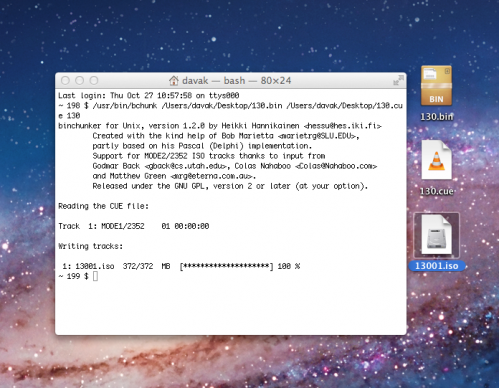Opening bin and cue files can be very tricky on mac computers. These directions will walk you through the steps needed to convert these files to an iso file that can be easily mounted on your system. Better yet, this will work in OS X without the need for any additional software.
Unfortunately, mac computers do not natively handle bin/cue files. However, OS X will happily mount iso files without any additional software. So to use bin/cue files, we’ll just need to convert them to an iso file. A few expensive software programs will do this for you, but by following these steps you can do it for free.
Enjoy this screencast where I walk through the steps. Detailed directions can be found below.
1. Download and decompress bchunk.zip from the reference article for this tutorial.
2. Place the bchunk file in some obvious place. I put mine in the /usr/bin location. You’ll need to authenticate to copy the file over.
3. Now, we need to tell OS X that this is an executable file. Open terminal and type sudo a+x along with a space. Then drag bchunk from /usr/bin and drop it onto the terminal window. If you find that difficult, you can just copy and paste the command from here:
sudo chmod a+x /usr/bin/bchunk
5. You’ll need to give your password.
6. Next, we’ll run the executable. Drag/drop bchunk to the terminal window, then drag/drop your bin file to the terminal window, and then drag your cue file to the terminal window. Last, type in the location where you want your file to be saved. If you are having a tough time visualizing this, check out the screencast. The command will be in the following format:
/usr/bin/bchunk binfile cuefile outputfile
Here is my example of using 130.bin and 130.cue from my desktop and using 130 as the prefix on my iso name:
/usr/bin/bchunk /Users/davak/Desktop/130.bin /Users/davak/Desktop/130.cue 130
If you bin file did not come with a cue file, you can manually create a cue file using your text editor.
7. Once you have the command correctly entered, hit ENTER within the terminal and let the program run.
Here is some sample output (with emails removed):
binchunker for Unix, version 1.2.0 by Heikki Hannikainen
Created with the kind help of Bob Marietta ,
partly based on his Pascal (Delphi) implementation.
Support for MODE2/2352 ISO tracks thanks to input from
Godmar Back, Colas Nahaboo
and Matthew Green.
Released under the GNU GPL, version 2 or later (at your option).
Reading the CUE file:
Track 1: MODE1/2352 01 00:00:00
Writing tracks:
1: 13001.iso 372/372 MB [********************] 100 %
8. You should now find a new .iso file on your desktop. Double-click this file to mount it and use the contents.

